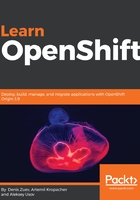
OpenShift flavors
OpenShift for production comes in several variants:
- OpenShift Origin
- OpenShift Container Platform
- OpenShift Online
- OpenShift Dedicated
As with other products under the Red Hat umbrella, OpenShift has an upstream project called OpenShift Origin. The OpenShift Origin homepage is available at http://openshift.org. It has a number of installation methods, including the installation of a development environment on a local developer machine.
Red Hat OpenShift Container Platform is a production-ready build of OpenShift Origin with all Red Hat production advantages including official support, certification, and so on. OpenShift Container Platform integrates with Red Hat Enterprise Linux and is tested via Red Hat's QA process in order to offer a stable, supportable product for customers who want to have their own private or on-site cloud. An enterprise might get updates every six months, maintaining stabilization across minor updates. OpenShift Container Platform allows for building a private or public PaaS cloud on your infrastructure.
Red Hat OpenShift Online is a multi-tenant public cloud managed by Red Hat. OpenShift Online can be a good choice for companies that want to start working with OpenShift but don’t want to have their own on-premise infrastructure. This platform allows for hosting a small application for free.
Red Hat OpenShift Dedicated is a single-tenant container application platform hosted on Amazon Web Services (AWS) or Google Cloud Platform and managed by Red Hat. It allows application development teams to quickly build, deploy, and scale traditional and cloud-native applications. OpenShift Dedicated is built on Red Hat Enterprise Linux, Docker container technology, and Google Kubernetes for orchestration and management. It securely connects to your data center so you can implement a flexible, hybrid cloud IT strategy with minimal infrastructure and operating expenses. It can be a good choice for companies who don’t want to share the platform with other companies.